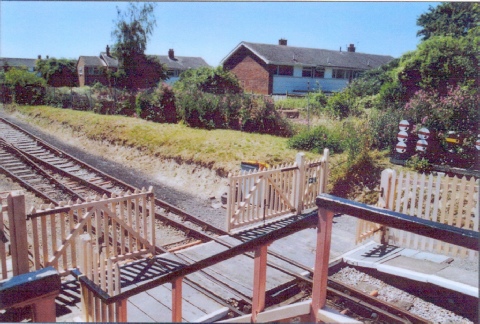Another Rescue and the Move to Chinnor.

From it’s inception, Chinnor and Princes Risborough Railway operated a version of traditional "One Engine in Steam" (OES) regulations. No train might occupy the single line unless its driver had what we call the "token" (which is a bit like a giant engraved key) as his authority. The points at Chinnor were worked from levers (known as a "ground frame") in a small hut, and were locked normal and could only be released using the token. No other loco or train was allowed to enter Chinnor station or leave the yard while the service train was out with the token.
Though limiting, this was a simple system which had served the Railway well through its formative years. But in the belief that the Railway will (must) grow, we must plan for the future.
We will want to:
Bring a display or other train into the platform between services;
Run round trains from Risborough without forcing passengers off first;
Use the loop to run round train 1 while train 2 works the line, to reduce service interval and increase capacity (especially post-
Work a shuttle South to Crowell Crossing or beyond;
Work through trains from Risborough to Crowell or beyond;
Cross two such trains at Chinnor.
The original arrangements simply would not allow such developments. At minimum more levers would be needed, in a larger cabin. At the top end of the scale would be a fully signalled operation at Chinnor.
Discussing this informally over the years, the conclusion seemed to be that one day we would need to build a replica signal box next to the Chinnor station foot crossing. Initially it could just take over the original ground frame functions and provide shelter for the crossing keeper who could then do both jobs. It would become a "Crossing Box", not a full block post. But the structure should be designed so that as the railway grew more functions could be added, and evolution into a fully fledged signal box would be possible if/when it became justified.
As always, there was a snag. The obvious GWR two-
Despite the argument that we should do all we could to get Chinnor developed before we had to divert manpower to the Risborough end of the line, it seemed likely that it would be a few years before the need for a new signal cabin at Chinnor became a priority for CPRRA resources. The project would remain a dream. But then opportunity knocked.
In 2006 the railway was offered a small signal box. It would come together with its lever frame, and some GW furniture, equipment and even a couple of signals. It’s saviour having sadly passed away, his family sought a fitting new home where the cabin would be used, cared for, and admired by the public. Pleasingly, they offered it to Chinnor.

The Chinnor & Princes Risborough Railway Association is a registered charity, number 1016237. It and the railway it owns are operated, managed, developed and maintained entirely by volunteers.
©PRNB 2015 Updated: 16/12/2015 E&OE
So this was a very lucky and unrepeatable opportunity we could not afford to miss, and work on solving the transport, design, excavation, building and access challenges progressed apace. A small team started repair and restoration of the exterior of the box in situ in the garden near Maidenhead, to protect it from the worst of the coming Winter's weather.
Of course this opportunity was not predicted, and the Association budget could not afford to fund the whole project. We had to find another way. An appeal to members for funds was launched, and thankfully the minimum £6500 estimated to make the move possible was quickly found.
The hope was to build foundations at Chinnor and move the cabin during the 2006/7 closed season and work on the interior through 2007. The operating functions of the existing ground frame could be transferred a year later. With the base infrastructure in place, subsequent works would progress as the operating needs of the Railway evolved.
In fact timescales slipped a bit, and the cabin was actually moved on 15th of June 2007.
Then came the minor matter of restoration…….

Careful measurement showed that as this single-
| Working Life |
| The Wilderness Years |
| Recent history until Nov 2013 |
| Recent works 2 |
| Recent History (from 2014) |
| CPRRA Years (2017/18) |
| Mouldsworth |
| Discovery |
| Rescue |
| Restoration |